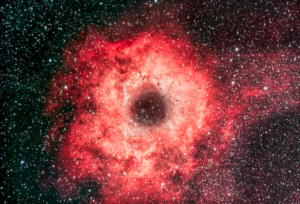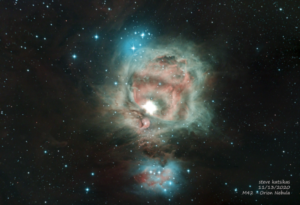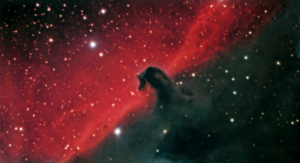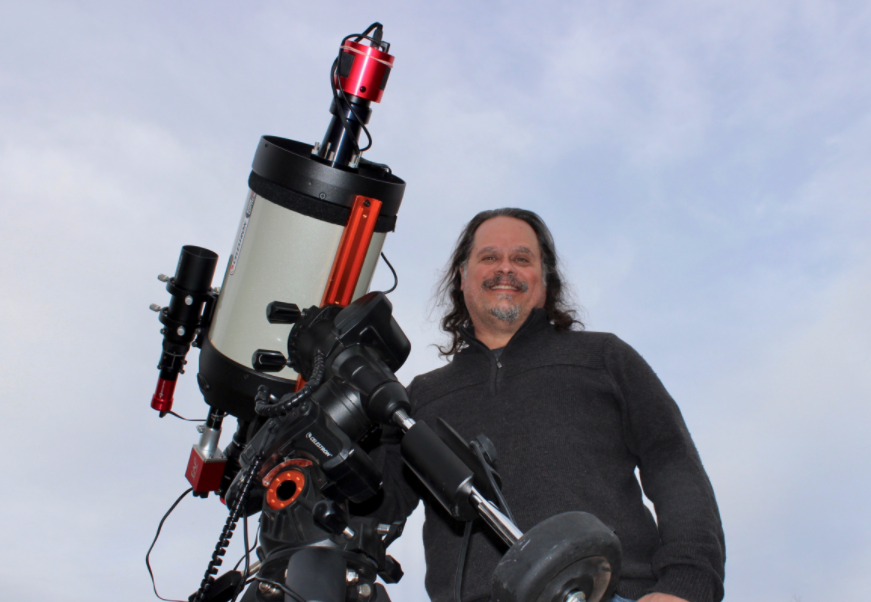Steve Katsikas Looks to the Stars
Photography / Provided
 To begin, Steve Katsikas is an accomplished educator and well adept at astrophotography. He and his family are from Miami, Florida, where he worked as director of Child/Adolescent Psychological Services at the University of Miami Miller School of Medicine and Jackson Memorial Hospital. In 2006, they pulled up roots and moved to Louisville, where Katsikas accepted the position of chairman for the psychology department at Spalding University. He now works as a professor of psychology at Spalding, and he just completed his term as president of the Kentucky Psychological Association.
To begin, Steve Katsikas is an accomplished educator and well adept at astrophotography. He and his family are from Miami, Florida, where he worked as director of Child/Adolescent Psychological Services at the University of Miami Miller School of Medicine and Jackson Memorial Hospital. In 2006, they pulled up roots and moved to Louisville, where Katsikas accepted the position of chairman for the psychology department at Spalding University. He now works as a professor of psychology at Spalding, and he just completed his term as president of the Kentucky Psychological Association.
Katsikas is also an accomplished musician and is a performer, songwriter and producer. He and his wife Joanna have their own band, Grackle, and he plays with a Pink Floyd tribute band called “Dark Side of the Wall.” Katsikas has released seven albums with various bands, and he released his debut solo album last year titled “Hidden Village.”
But most recently, Katsikas began a new hobby: astrophotography, also known as astronomical imaging. It involves photographing astronomical objects, celestial events, and various areas of the night sky. It is one of the more equipment-intensive and technical forms of photography, one that takes time and patience to master. Ultimately, with a great deal of practice and study, the results are quite spectacular, as you can see by looking at the photos here that were taken by Katsikas.
His interest in astronomy began in 1995 when he and Joanna began attending ‘star parties.’ “Joanna and I bought a good telescope for our fifth anniversary and really started to spend a good deal of time in the Everglades with the star club,” he says. “We got out of the hobby while raising our children, but we’ve gotten back into it recently, joining the Louisville Astronomical Society in March of 2020.”
Katsikas’s first telescope was given to him by his uncle George. “It was an old Tasco 4.5(-inch) and I can distinctly remember, as a kid, being able to see Saturn’s rings with it,” he says. “As mentioned, Joanna and I bought our first big telescope in 1998 — a Meade 10-inch Starfinder. It was a beast, hard to move around, but gave great views of the planets and nearby nebula.”
Once Covid-19 hit, Katsikas says began thinking about more solitary hobbies and decided he wanted to trade the Meade for something smaller and more manageable. “I found a used Celestron EdgeHD 8-inch telescope for sale in Northern Kentucky,” he says. “Once I started using that, I got the bug to start taking images and it became very addictive — in a good way!”
 Going from raw images to final pictures is a complex and detailed process, Katsikas explains. “It starts with ‘stacking’ multiple pictures of your object,” he says. “I use software called DeepSkyStacker for that task. Then, you have to process your image with a program like Photoshop to bring out the colors and faint details. I spend a great deal of time reading, watching YouTube videos and asking questions in forums to learn how to process images. I am nowhere close to the skill level of many experienced folks who have helped me. I see myself as ‘very apprentice’ in my skills, but I am also quite committed to getting better with each observing session.”
Going from raw images to final pictures is a complex and detailed process, Katsikas explains. “It starts with ‘stacking’ multiple pictures of your object,” he says. “I use software called DeepSkyStacker for that task. Then, you have to process your image with a program like Photoshop to bring out the colors and faint details. I spend a great deal of time reading, watching YouTube videos and asking questions in forums to learn how to process images. I am nowhere close to the skill level of many experienced folks who have helped me. I see myself as ‘very apprentice’ in my skills, but I am also quite committed to getting better with each observing session.”
Most objects that he images are nebula, that is, areas of gas that are energized. “Typically, they are made from hydrogen and can be the ‘birthplace of stars’,” he says. “I’ve also imaged a few galaxies. When you look at the stars at night, every star you see is in the Milky Way. The few galaxies I have imaged are far beyond any star we can see. I have also imaged some star clusters, supernova remnants, and a few closer objects like Mars, Jupiter, Saturn and the Moon.”
Katsikas loves this hobby, he says, because it’s a balance of nature, art, and technology. “It is complicated and difficult, so when I get a good photo, I feel like I have really accomplished something,” he says.
The main joy is just enjoying the incredible beauty of the night skies, he says. “It is overwhelming to consider the scale of what I am imaging. For example, the Orion Nebula is twelve light years across. That amazing, glowing, colorful object is so huge, that light takes 12 years to traverse it. And it is just a fist size (as you extend your hand) in the sky. I love processing the images because I often have no idea how the images will look. It is kind of like discovering treasure when it all comes into focus and color.”
Most of the time, Katsikas shoots his gorgeous photos right from his driveway, but he’s also taken his telescope to Liberty and Science Hill to get his very best shots. “Dark skies are the key to great photos,” he explains. “It is my goal this summer, conditions pending, to take the scope out West to the desert and image from the darkest skies in the U.S.”
 His love of the skies and all it holds has also taken him to other parts of the bluegrass state.
His love of the skies and all it holds has also taken him to other parts of the bluegrass state.
“I had never seen a total eclipse of the sun before 2017,” he says. “We drove to a small town called Princeton, Kentucky, and set up a blanket in a school’s athletic field with about 100 other people. I was not prepared for the emotional impact of the moment when the sun went away. We could see stars, the temperature dropped, and I found myself crying and screaming like I was at a rock concert. It was unbelievable, and I have already made plans to see the next one in 2024.”
Katsikas offers solid advice to those who’d like to learn more about astronomy and astrophotography.
“I would suggest that folks start with observing,” he says. “Learn how to use your telescope and find your way around the sky. Then, if the astrophotography bug is biting, make the jump incrementally. There are no short cuts to getting good imaging, but I’d always encourage folks start with used gear. You need a decent telescope, a really good mount for tracking, and a good camera. Most DSLR cameras can be used in the beginning to capture images. I have a friend, Ronnie Yates, who does all his astrophotography with a Canon Ti3 camera and gets the best photos.”
He says that dedicated astrophotography cameras are the easiest to use. “Anyone interested should, for sure, join their local astronomy club first to get access to a ton of experienced and passionate folks,” he says. “I am a total beginner at this stage. I am humbled every day by the images I see in the many groups I joined for astrophotography. I love the fact that there is no finish line to this hobby. I am thrilled that this newbie gets to share his images with so many folks who also enjoy them. The universe belongs to all of us.”
If you’d like to learn more about local astronomy and how to become involved with astronomy, visit the site for the Louisville Astronomical Society at Louisville-astro.org.






